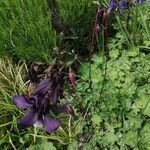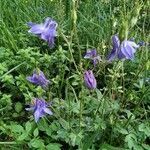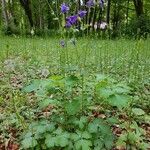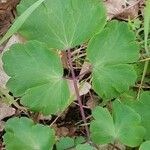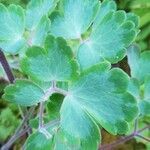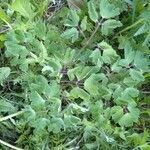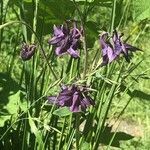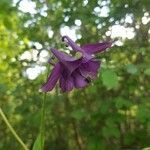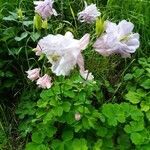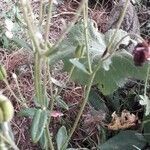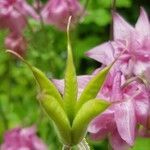Stems 1-several, leafy, 30-80 cm tall, pilose at least above. Lvs dull dark green and glabrous above, pale, glaucous, and sparsely pilose beneath. Basal lvs petiolate, 2-ternate; segments shortly stalked, lobed, crenate. Stem lvs shortly petiolate, becoming 3-foliolate; segments becoming sessile. Fls in lax leafy cymes, nodding, 2.5-3.5-(5) cm diam. Sepals ovate, acute, violet, blue, red or pink, (1.5)-2-3 cm long. Petals same colour as sepals but paler; limb < sepals, truncate; spur > limb, hooked at tip. Staminodes truncate at tip. Carpels hairy. Follicles 5-(7), strongly veined, erect, 15-30 mm long; styles deciduous, 6-8 mm long.
Stems 30-72 cm. Basal leaves 2×-ternately compound, 10-30 cm, much shorter than stems; leaflets green adaxially, to 15-47 mm, not viscid; primary petiolules 22-60 mm (leaflets not crowded), pilose or rarely glabrous. Flowers nodding; sepals divergent from or perpendicular to floral axis, mostly blue or purple, lance-ovate, (10-)15-25 × 8-12 mm, apex broadly acute or obtuse; petals: spurs mostly blue or purple, hooked, 14-22 mm, stout, evenly tapered from base, blades mostly blue or purple, oblong, 10-13 × 6-10 mm; stamens 9-13 mm. Follicles 15-25 mm; beak 7-15 mm. 2 n = 14 (Europe).
Foliage as in no. 1 [Aquilegia canadensis L.]; fls nodding, blue, varying to purple, white, or pink, (2.5–)3–4(–5) cm long and wide, stamens not longer than the sep; spurs short and thick, strongly incurved; follicle-beak 5–10 mm; 2n=14. Native of Eurasia, escaped from cult. and locally established esp. in the cooler parts of our range. May–July.
A herb. It is tall and branched and grows for a few years. It grows 70 cm tall and 30 cm wide. The flowers are blue.
